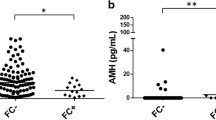Abstract
Serum concentration of anti-Müllerian hormone (AMH) is a useful marker for ovarian reserve. Measurement of AMH in clinical practice has gained widespread use to predict parameters such as the ovarian response, menopause, and recovery after chemotherapy. However, undetectable AMH levels assayed by conventional enzyme-linked immunosorbent assay (ELISA) kits fail to predict depletion of follicles because of low sensitivity of the kits. We investigated whether a recently developed ultrasensitive ELISA kit, picoAMH, would be more effective at detecting very low AMH levels in association with menstrual status. We analyzed 68 women with undetectable serum AMH levels using an ELISA kit, AMH Gen II. The AMH concentration of the same samples was detected in 36 samples using picoAMH; 32 samples were within the standard range, and 4 samples were out of the standard range but still detectable. Thirty-two women whose AMH levels were undetectable using the picoAMH all showed amenorrhea. We also found a significant correlation between the classes of serum AMH levels (undetectable, detectable under the limit of quantification, and measurable within the assay range) and menstrual status. Five of the 6 amenorrheic women with detectable AMH eventually achieved follicle growth. The present study demonstrated that very low AMH levels detectable using picoAMH correspond well to current and future ovulation status. This suggests that serum AMH levels can be useful for the assessment of ovarian reserve and follow-up of women with a declined ovarian reserve.
Similar content being viewed by others
References
Nelson SM. Biomarkers of ovarian response: current and future applications. Fertil Steril. 2013;99(4):963–969.
Loh JS, Maheshwari A. Anti-Mullerian hormone—is it a crystal ball for predicting ovarian ageing? Hum Reprod. 2011;26(11): 2925–2932.
Broer SL, Broekmans FJ, Laven JS, Fauser BC. Anti-Mullerian hormone: ovarian reserve testing and its potential clinical implications. Hum Reprod Update. 2014;20(5):688–701.
Iwase A, Nakamura T, Nakahara T, Goto M, Kikkawa F. Assessment of ovarian reserve using anti-Mullerian hormone levels in benign gynecologic conditions and surgical interventions: a systematic narrative review. Reprod Biol Endocrinol. 2014;12:125.
Iwase A, Nakamura T, Nakahara T, Goto M, Kikkawa F. Anti-mullerian hormone and assessment of ovarian reserve after ovarian toxic treatment: a systematic narrative review. Reprod Sci. 2015;22(5):519–526.
Anderson RA, Cameron DA. Pretreatment serum anti-mullerian hormone predicts long-term ovarian function and bone mass after chemotherapy for early breast cancer. J Clin Endocrinol Metab. 2011;96(5):1336–1343.
Decanter C, Morschhauser F, Pigny P, Lefebvre C, Gallo C, Dewailly D. Anti-Mullerian hormone follow-up in young women treated by chemotherapy for lymphoma: preliminary results. Reprod Biomed Online. 2010;20(2):280–285.
Broer SL, Eijkemans MJ, Scheffer GJ, et al. Anti-mullerian hormone predicts menopause: a long-term follow-up study in normoovulatory women. J Clin Endocrinol Metab. 2011;96(8):2532–2539.
Sowers MR, Eyvazzadeh AD, McConnell D, et al. Anti-mullerian hormone and inhibin B in the definition of ovarian aging and the menopause transition. J Clin Endocrinol Metab. 2008;93(9): 3478–3483.
Broekmans FJ, Kwee J, Hendriks DJ, Mol BW, Lambalk CB. A systematic review of tests predicting ovarian reserve and IVF outcome. Hum Reprod Update. 2006;12(6):685–718.
Kato N, Iwase A, Sugita A, et al. Anti-Mullerian hormone as a possible predictor of fecundability in subfertile women over 38 years: a retrospective cohort study. Gynecol Endocrinol. 2015; 31(1):22–25.
Reichman DE, Goldschlag D, Rosenwaks Z. Value of antimullerian hormone as a prognostic indicator of in vitro fertilization outcome. Fertil Steril. 2014;101(4):1012–1018.e1.
Li HW, Ng EH, Wong BP, Anderson RA, Ho PC, Yeung WS. Correlation between three assay systems for anti-Mullerian hormone (AMH) determination. J Assist Reprod Genet. 2012; 29(12):1443–1446.
Su HI, Sammel MD, Homer MV, Bui K, Haunschild C, Stanczyk FZ. Comparability of antimullerian hormone levels among commercially available immunoassays. Fertil Steril. 2014;101(6): 1766–1772.e1.
Welsh P, Smith K, Nelson SM. A single-centre evaluation of two new anti-Mullerian hormone assays and comparison with the current clinical standard assay. Hum Reprod. 2014;29(5):1035–1041.
Chai J, Howie AF, Cameron DA, Anderson RA. A highly-sensitive anti-Mullerian hormone assay improves analysis of ovarian function following chemotherapy for early breast cancer. Eur J Cancer. 2014;50(14):2367–2374.
Decanter C, Peigne M, Mailliez A, et al. Toward a better follow-up of ovarian recovery in young women after chemotherapy with a hypersensitive antimullerian hormone assay. Fertil Steril. 2014; 102(2):483–487.
Hirokawa W, Iwase A, Goto M, et al. The post-operative decline in serum anti-Mullerian hormone correlates with the bilaterality and severity of endometriosis. Hum Reprod. 2011;26(4):904–910.
Iwase A, Hirokawa W, Goto M, et al. Serum anti-Mullerian hormone level is a useful marker for evaluating the impact of laparoscopic cystectomy on ovarian reserve. Fertil Steril. 2010;94(7): 2846–2849.
Iwase A, Sugita A, Hirokawa W, et al. Anti-Mullerian hormone as a marker of ovarian reserve in patients with ovarian malignancies who have undergone fertility-preserving surgery and chemotherapy. Gynecol Endocrinol. 2013;29(4):357–360.
Iwase A, Sugita A, Hirokawa W, et al. Anti-Mullerian hormone as a marker of ovarian reserve following chemotherapy in patients with gestational trophoblastic neoplasia. Eur J Obstet Gynecol Reprod Biol. 2013;167(2):194–198.
Sugita A, Iwase A, Goto M, et al. One-year follow-up of serum anti-mullerian hormone levels in patients with cystectomy: are different sequential changes due to different mechanisms causing damage to the ovarian reserve? Fertil Steril. 2013;100(2):516–522.e3.
Faddy MJ, Gosden RG, Gougeon A, Richardson SJ, Nelson JF. Accelerated disappearance of ovarian follicles in mid-life: implications for forecasting menopause. Hum Reprod. 1992;7(10): 1342–1346.
Freeman EW, Sammel MD, Lin H, Gracia CR. Anti-mullerian hormone as a predictor of time to menopause in late reproductive age women. J Clin Endocrinol Metab. 2012;97(5):1673–1680.
Hagen CP, Vestergaard S, Juul A, et al. Low concentration of circulating antimullerian hormone is not predictive of reduced fecundability in young healthy women: a prospective cohort study. Fertil Steril. 2012;98(6):1602–1608.e2.
Author information
Authors and Affiliations
Corresponding author
Rights and permissions
About this article
Cite this article
Iwase, A., Osuka, S., Nakamura, T. et al. Usefulness of the Ultrasensitive Anti-Müllerian Hormone Assay for Predicting True Ovarian Reserve. Reprod. Sci. 23, 756–760 (2016). https://doi.org/10.1177/1933719115618284
Published:
Issue Date:
DOI: https://doi.org/10.1177/1933719115618284



